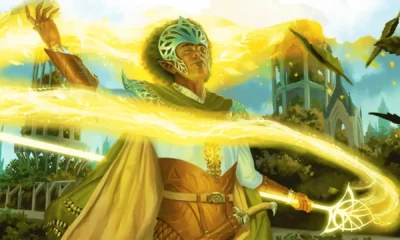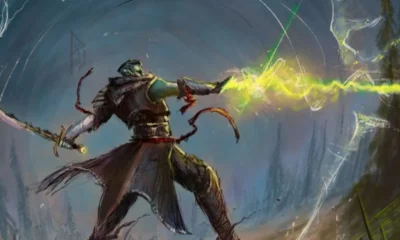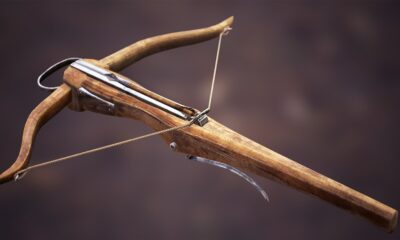Dungeons & Dragons
Shatter 5e D&D Guide

Today, we delve deep into the arcane mysteries of the Shatter spell in Dungeons & Dragons 5th Edition.
Buckle up, because we’re about to embark on a sonic journey that will leave your enemies shattered and your fellow players in awe.
If you’ve ever wanted to wield the power of sound like a weapon, you’re in the right place.
What Is The Shatter Spell?
According to the Player’s Handbook, here are the stats for the shatter spell:
- Shatter
- 2nd level evocation
- Casting Time: 1 action
- Range: 60 feet
- Components: V S M (A chip of mica)
- Duration: Instantaneous
- Classes: Bard, Sorcerer, Warlock, Wizard

In the vast tapestry of spells available to magic users, Shatter stands out as a second-level evocation spell.
With a mere chip of mica, you can create a sudden, ear-splitting noise within 60 feet, wreaking havoc in a 10-foot-radius sphere.
Every creature in this zone must face a Constitution saving throw, or suffer 3d8 thunder damage.
But that’s not all! Inorganic beings made of stone, crystal, or metal face a disadvantage on this saving throw.
Plus, non-magical objects, even if hidden in chests, aren’t safe either. They, too, crumble under the power of Shatter.
At Higher Levels: When you cast this spell using a spell slot of or higher, the damage increases by 1d8 for each slot level above 2nd
How to Uses Shatter Spell?
Now, let’s talk strategy. Picture this: a pesky golem, resistant to conventional attacks, suddenly vulnerable to the wrath of Shatter.
With a booming clap, you can bypass their defenses and deal significant damage. Locked doors or chests?
Shatter them into submission, revealing the treasures within or allowing your party to progress without a hitch.
And if you’re feeling particularly mischievous, combine Shatter with a command spell to make your enemies drop their weapons, leaving them defenseless against the ensuing auditory onslaught.
But beware, dear readers, this spell isn’t without its quirks. The sound might be deafening within the 10-foot radius, but it’s muffled beyond.
So, while you might not create a cacophony heard miles away, you’ll definitely leave an impression on those nearby.
How Loud Is Shatter?
We’ll compare shatter and thunderclap in more detail later in the text, but shatter doesn’t tell you how loud the sound you make is.
Most players understand the spell as being extremely loud in the ten-foot radius that it encompasses. Outside of that realm, however, it is muffled.
If you use shatter to smash anything, the sound of those objects breaking apart and falling to the floor will undoubtedly be audible.
Shatter’s effect can be particularly loud in this instance. Thunderclap is a unique spell in that it produces a blast of thunderous sound that may be heard from 100 feet away.
Both spells are quite loud, but Thunderclap is unquestionably louder for everyone. Shatter’s piercing noise is only audible when you are within a ten-foot radius.
The Effects Of Being Shattered
When you cast the shattered spell on a stone, crystal, or metal creature, it gives them a -1 penalty on their saving throw to resist the damage.
The thunderclap also damages any nonmagical goods that aren’t worn or carried. Both of these additional effects can significantly alter how you approach certain confrontations.
For one thing, if your group encounters a golem or other stone creature, they usually have a high resistance to traditional sources of damage.
In truth, the golem’s stat block claims that it has magic resistance to spells and is immune to bludgeoning, piercing, and slashing damage from non-adamantine or magical weapons. Crystals and other inorganic materials behave similarly.
However, shattered spells allow you to bypass a golem’s intrinsic damage resistance and deal a lot of damage, especially with a higher-level spell slot. If you’re up against some inorganic foes, this can help you turn the tide.
Non-magical artifacts also incur damage if they are within the ten-foot bubble, which is an intriguing effect.
While this can be used to help destroy terrain in order to enhance speed and deny the enemy’s cover, you can also use it to shatter objects like doors and other locked impediments, or at least damage them enough for physical damage to offer the finishing touches for breakthrough. It’s the next best thing if you don’t have a key!
What Is Mica?
The Shatter spell’s material component is ‘a chip of mica.’ Mica is a pearly luster gemstone that can have up to 34 layers.
It has been discovered all over the world and was originally mined for export and trading. Because the stone is not very durable, it is frequently found in powder form and is used as an accent in jewelry.
It is also rather widespread and can be found on all continents in the real world, and it is relatively inexpensive if you need a large quantity of low-quality mica.
Because it easily flakes off into sheets, a huge mica rock can flake off in dozens of pieces, and the chip is not wasted when casting the spell.
So, if your players are shopping for Mica and you want to replicate the actual world, it should be fairly easy to get and quite inexpensive.
It should be plentiful in mining communities as well. They can place a chip in their regents’ pouch and never worry about it again.
Shatter vs. Thunderclap
Comparing Shatter to a similar spell, Thunderclap, reveals an intriguing competition. Thunderclap offers a wider auditory range, audible up to 100 feet away.
However, when it comes to raw damage and versatility, Shatter takes the lead. Its 3d8 thunder damage dwarfs Thunderclap’s 1d6, making it a formidable choice for any aspiring spellcaster.
Additionally, Shatter boasts a 60-foot range, leaving your enemies no place to hide.
Both of these are excellent spells to utilize, and they both deal with sound. Thunderclap has a lot louder sound, as previously noted, and the stats are as follows, according to Xanathar’s Guide To Everything:
You produce a deafening explosion that can be heard up to 100 feet away. Other than you, any creature within range must succeed on a Constitution saving throw or take 1d6 thunder damage.
When you reach the 5th level (2d6), 11th level (3d6), and 17th level (4d6), the spell’s damage increases by 1d6.
When it comes to shatter, thunderclap has a few drawbacks. To begin with, most difficult monsters have high constitution saves and will be able to withstand the blow. They do not take any harm if they pass the save. Furthermore, you only have a 5ft range on the spell, whereas shatter has a 60ft range.
You also have 1d6 thunder damage vs 3d8 thunder damage at the first level, thus shatter is a significantly stronger spell in terms of damage. All of this being said, thunderclap offers a few non-game benefits if you wish to establish a signal for your party by using thunderclaps on a cloudy day.
While thunderclap is an intriguing cantrip, shatter blasts it out of the water in all but sound. Give it a shot once you reach the second level, and you’ll soon be replacing thunderclap for it!
Is Shatter 5E a good spell?
Shatter is a solid AoE spell for a second level slot; while it lacks the push effect of its lower-level relative Thunderwave, the range makes it far safer and easier to deploy.
Its capacity to harm objects provides it with some versatility, which can be utilized to blast your way through some obstacles or perhaps change the environment to your favor, such as by collapsing a bridge.
It’s worth noting that it’s one of the few damage-oriented options accessible to Bards, making it a more valuable spell for them.
The Tempest Cleric’s Channel Divinity, which lets you to use the maximum damage value instead of rolling dice, is one way to improve this spell.
Shatter is a Spell-Storing Item available to Armorer and Artillerist Artificers, allowing it to be used essentially as a cantrip with a +5 Int bonus.
Artillerists can also use their Arcane Firearm feature to boost the spell’s damage by an extra d8, essentially free upcasting!

-

 Dungeons & Dragons6 months ago
Dungeons & Dragons6 months agoAberrations 5e D&D Guide
-

 Dungeons & Dragons6 months ago
Dungeons & Dragons6 months agoUnderstanding Size Categories in Dungeons & Dragons Guide
-

 Dungeons & Dragons6 months ago
Dungeons & Dragons6 months agoHeavy Crossbow 5e D&D Guide
-

 Dungeons & Dragons6 months ago
Dungeons & Dragons6 months agoMinor Illusion 5E D&D Guide
-

 Dungeons & Dragons6 months ago
Dungeons & Dragons6 months agoHerbalism Kit 5e D&D Guide
-

 Dungeons & Dragons6 months ago
Dungeons & Dragons6 months agoThaumaturgy 5e D&D Guide
-

 Dungeons & Dragons6 months ago
Dungeons & Dragons6 months agoRay of Sickness 5e Dungeons & Dragons Guide
-

 Dungeons & Dragons6 months ago
Dungeons & Dragons6 months agoLight Crossbow 5e D&D Guide
